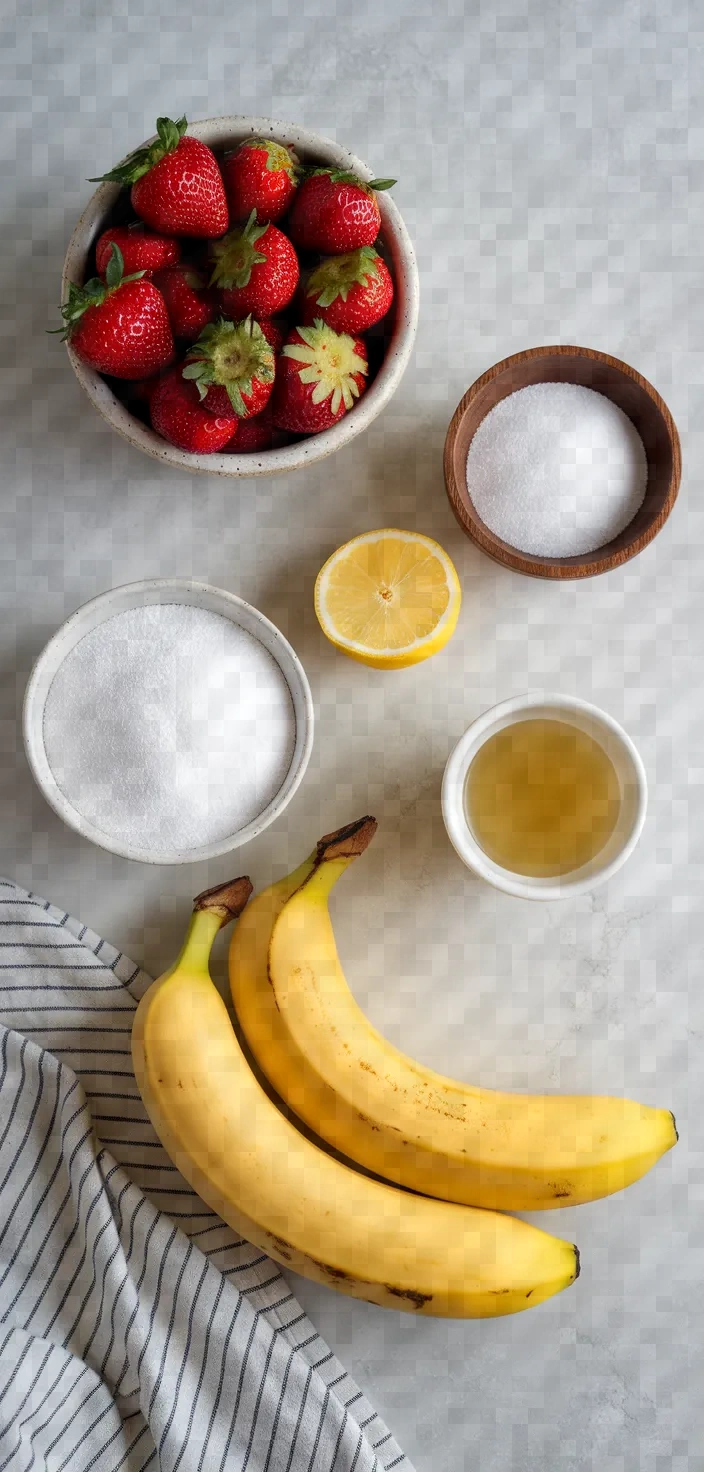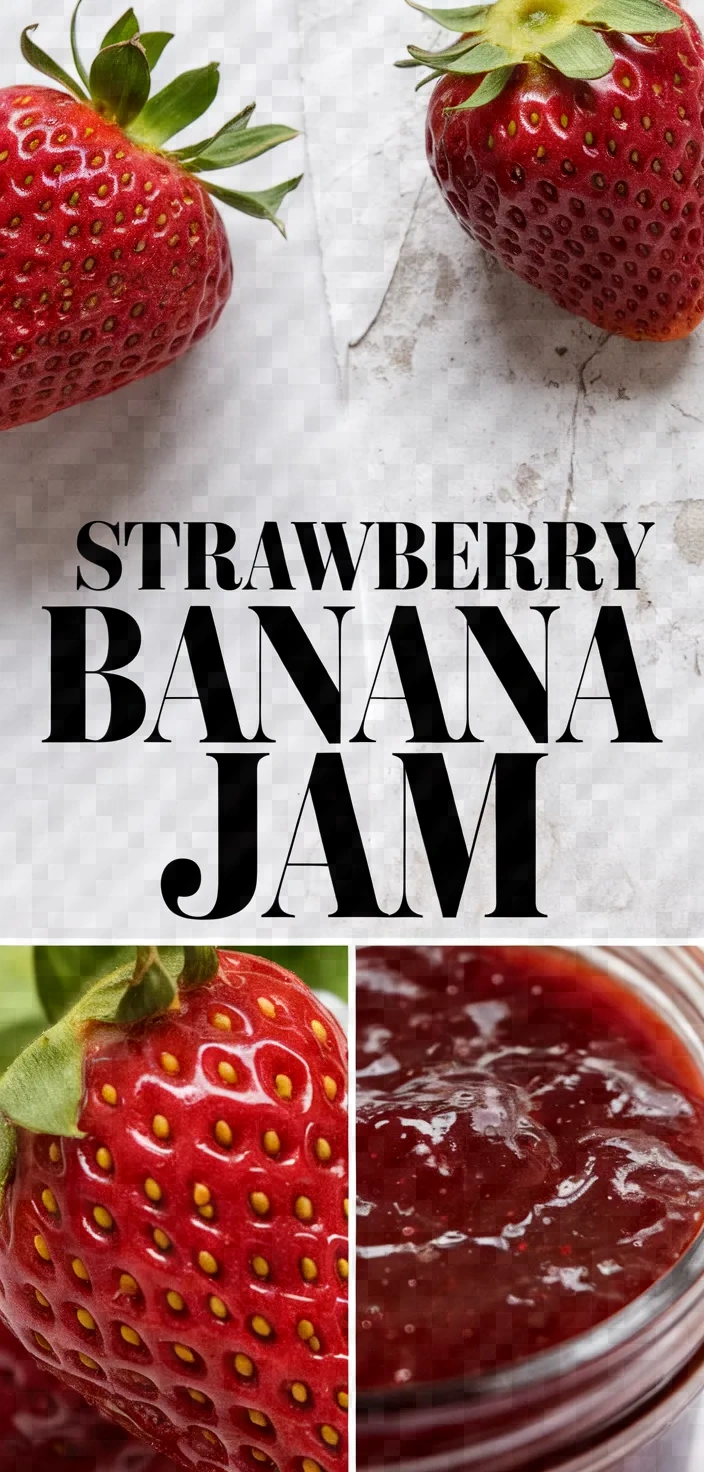I absolutely love this strawberry banana jam recipe because it’s like capturing the taste of summer in a jar, combining the sweetness of ripe strawberries and bananas with a zesty lemon twist. Plus, the excitement of making and canning my own jam from scratch makes me feel like a kitchen wizard, ready to share delicious homemade treasures with friends and family!

I enjoy making tollen spreads, such as my Strawberry Banana Jam. It requires 2 cups of strawberries and 1 cup of mashed ripe bananas.
The jam has a delightfully fruity taste but remember that it’s not a low-sugar option. You are going to need some granulated sugar, and I’ve always preferred using a full 3 cups for this jam, but if you’re experimenting with this recipe, you can lessen the amount of sugar.
The jam is going to be less sweet and more fruity, and I imagine you might even like it better that way!
Ingredients

Strawberries: Full of vitamin C and antioxidants; sweet and slightly tangy.
Potassium, natural sweetness, and the creamy texture of bananas make them hard to beat.
Juice from Lemons: Supplies a sharp flavor, tempers levels of sweetness, and serves as a natural preservative.
Main sweetener, helps in setting the jam: Granulated Sugar.
Pectin: Liquid pectin is what thickens and sets the jam to the right consistency.
Ingredient Quantities
- 2 cups strawberries, hulled and diced
- 1 cup mashed ripe bananas (about 2 medium bananas)
- 1/4 cup lemon juice
- 3 cups granulated sugar
- 1 pouch (3 oz) liquid pectin
Instructions
1. In a large saucepan, medium heat, and frequent stirring. Combine the strawberries, mashed bananas, and lemon juice.
2. Slowly incorporate the sugar into the fruit mixture, and keep stirring until the sugar has completely dissolved.
3. Raise the heat to high and bring the mixture to a full, rolling boil that cannot be stirred down. Stir to the beat of “The William Tell Overture,” for about five minutes.
4. Once the liquid is boiling vigorously, quickly stir in the liquid pectin.
5. Give the blend back to a full roiling boil, and boil for exactly 1 minute, stirring constantly.
6. Take the saucepan from the heat and remove any foam that has formed on the surface.
7. Ensure the jars you will use for canning are clean and dry, and are of a temperature appropriate for the food to be stored. You can sterilize the jars by placing them in a boiling water bath for 10 minutes or by running them through a cycle in the dishwasher, using the “sanitize” setting if your machine has one.
8. Ladle the hot jam into the sterilized jars with care, and leave about 1/4 inch of space at the top.
9. Clean the rims of the jars with a cloth that is both clean and damp, then seal them with the appropriate lids and bands.
10. Ensure proper sealing of the jars by processing them in a boiling-water canner for 10 minutes; afterwards, let the jars cool completely at room temperature.
Equipment Needed
1. Large saucepan
2. Wooden spoon or heat-resistant spatula
3. Measuring cups
4. Medium bowl (for mashing bananas)
5. Potato masher or fork (for mashing bananas)
6. Ladle
7. Sterilized canning jars with lids and bands
8. Clean, damp cloth
9. Boiling-water canner
10. Jar lifter (optional, but recommended for safety)
FAQ
- Q: Can I use frozen strawberries?Q: Can you use frozen strawberries?
A: Yes, you can use frozen strawberries. Just make sure they are completely thawed and drained before using them in the recipe.
- Q: How can I ensure the jam sets properly?A: Ensure that you carry out the instructions to the letter. It is vitally important that you incorporate both lemon juice and liquid pectin into the mix; their presence is crucial for the jam to have any hope of setting up properly.
- Q: Can I reduce the amount of sugar?Reducing sugar can influence (and negatively affect) the setting and preservation of the jam. For that reason, it’s best to follow a recipe rather closely.
- Q: How long will the jam last once opened?B: When the jam jar is opened, it can be stored in the refrigerator and the jam can be consumed at optimal freshness within a 3-4 week time frame.
- Q: Can I use powdered pectin instead of liquid pectin?Liquid and powdered pectin are not directly interchangeable. If you are using powdered pectin, you should follow the package instructions for the correct amount and usage.
- Q: Is it necessary to sterilize the jars before filling them?Q: Does sterilizing jars prevent spoilage and help preserve jam?
Substitutions and Variations
When strawberries are not available, you can use either raspberries or blackberries in their stead; both fruits lend a berry-flavored essence to your dish that’s delicious in its own right.
Use pureed peaches or mangoes instead of bananas for a mashed tropical twist.
Instead of using lemon juice, use lime juice for an entirely different flavor profile. Both lemon and lime juice are acidic, which makes them a good substitute for each other, but lime juice has a flavor all its own that may alter the finished dish.
Replace granulated sugar with honey or agave syrup, remembering that the level of sweetness and the texture may differ.
Use powdered pectin instead of liquid pectin, using package directions for conversion.
Pro Tips
1. Ripeness Matters Use ripe but firm strawberries and overripe bananas for the best flavor and natural sweetness. The riper the bananas, the sweeter your jam will be, which may allow you to slightly reduce the amount of added sugar if desired.
2. Enhance the Strawberry Flavor Consider adding a touch of vanilla extract or a pinch of salt to enhance the strawberry flavor. These small additions can elevate the taste profile without overpowering the fruit.
3. Foam Removal After boiling, a layer of foam may form on top of the jam. Use a metal spoon to gently skim off the foam, as this will help ensure the final product is clear and aesthetically pleasing in the jars.
4. Pectin Timing Ensure that the liquid pectin is ready to be poured into the jam mixture as soon as it reaches a rolling boil. Timing is crucial for proper gelling, so be sure to follow this step quickly and efficiently.
5. Temperature of Jars Before ladling the hot jam, make sure the sterilized jars are still warm. Pouring hot jam into cold jars can lead to cracking due to thermal shock. You might keep the jars in a warm oven or hot water until ready to use.

Strawberry Banana Jam Recipe
My favorite Strawberry Banana Jam Recipe
Equipment Needed:
1. Large saucepan
2. Wooden spoon or heat-resistant spatula
3. Measuring cups
4. Medium bowl (for mashing bananas)
5. Potato masher or fork (for mashing bananas)
6. Ladle
7. Sterilized canning jars with lids and bands
8. Clean, damp cloth
9. Boiling-water canner
10. Jar lifter (optional, but recommended for safety)
Ingredients:
- 2 cups strawberries, hulled and diced
- 1 cup mashed ripe bananas (about 2 medium bananas)
- 1/4 cup lemon juice
- 3 cups granulated sugar
- 1 pouch (3 oz) liquid pectin
Instructions:
1. In a large saucepan, medium heat, and frequent stirring. Combine the strawberries, mashed bananas, and lemon juice.
2. Slowly incorporate the sugar into the fruit mixture, and keep stirring until the sugar has completely dissolved.
3. Raise the heat to high and bring the mixture to a full, rolling boil that cannot be stirred down. Stir to the beat of “The William Tell Overture,” for about five minutes.
4. Once the liquid is boiling vigorously, quickly stir in the liquid pectin.
5. Give the blend back to a full roiling boil, and boil for exactly 1 minute, stirring constantly.
6. Take the saucepan from the heat and remove any foam that has formed on the surface.
7. Ensure the jars you will use for canning are clean and dry, and are of a temperature appropriate for the food to be stored. You can sterilize the jars by placing them in a boiling water bath for 10 minutes or by running them through a cycle in the dishwasher, using the “sanitize” setting if your machine has one.
8. Ladle the hot jam into the sterilized jars with care, and leave about 1/4 inch of space at the top.
9. Clean the rims of the jars with a cloth that is both clean and damp, then seal them with the appropriate lids and bands.
10. Ensure proper sealing of the jars by processing them in a boiling-water canner for 10 minutes; afterwards, let the jars cool completely at room temperature.
